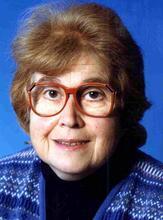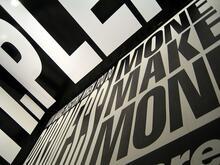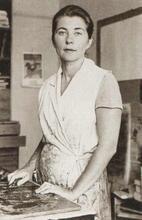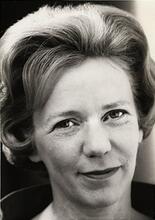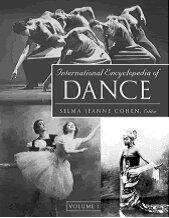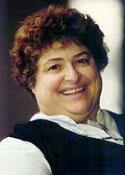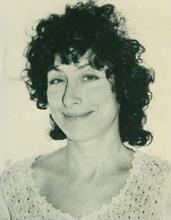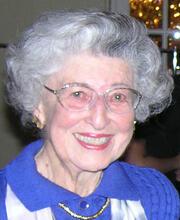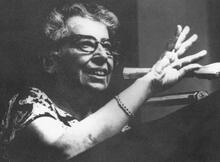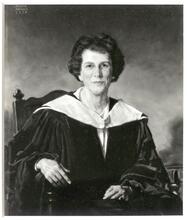Colette Roberts
Colette Roberts helped shape our understanding of modern art both through her art criticism and through her unconventional teaching methods, bringing students into artists’ studios to talk with them about their work. Roberts graduated from the University of Paris but also studied at the Louvre and other art schools. During WWII she immigrated to New York and in the 1940s she helped organize Franco-American cultural exchanges, becoming director of the National Association of Women Artists while serving as secretary to a curator at the Metropolitan Museum of Art. She wrote art criticism and monographs on modern artists in America and exhibited her own art in France. From 1952 to 1968 she directed the Grand Central Moderns gallery, bringing attention to previously unknown artists like Louise Nevelson.
Early Life & Career
Colette Jacqueline (Levy Rothschild) Roberts devoted her life to increasing people’s understanding and appreciation of modern art. She was born in Paris on September 16, 1910. She graduated from the University of Paris and then attended the École du Louvre and the Academy Ranson where she studied painting with Roger Bissière. She also studied at the Institut d’Art et Archéologie with Henri Focillon.
In 1934, when Colette was twenty-four, she married Edward Sherrill Roberts, an American engineer (they later divorced). During World War II, she moved alone with her young son, Richard Barclay, to the United States, where she became a citizen. She settled in New York City and worked as a lecturer and writer for the French press. In the early 1940s, she was instrumental in organizing Franco-American cultural exchanges and exhibitions, and in the late 1940s became the director of the National Association of Women Artists. Simultaneously, she served for a short time as secretary to the curator of Far Eastern art at the Metropolitan Museum of Art. For the remainder of her career, she lived in Manhattan and continued to focus her versatile talents in the field of the visual arts.
The influence of her former teacher Roger Bissière was so stimulating to Roberts’s understanding of the art of her day that in 1952 she decided to continue her studies, specializing in modern American art. From 1957, while continuing to exhibit her work in France, through 1968, she worked at New York University (NYU) as an instructor in the Division of Education (now the School of Continuing Education). Her popular course, “Meet the Artist,” was listed as “a rare opportunity to visit the studios of artists with national and international reputations, to view the artists’ work and to ask questions of the artists themselves.” The artists her students visited included Adolph Gottlieb, Willem de Kooning, Roy Lichtenstein, Louise Nevelson, and Ilya Bolotovsky. In 1968, she was an assistant professor at NYU, and the following year became the director of the Hofstra University Art Gallery, which was affiliated with NYU.
Writing & Legacy
From 1960 to 1967, Roberts wrote reviews of Manhattan gallery exhibitions for the highly respected Parisian journal Architecture d’Aujourd’hui. In addition, she contributed articles to France-Amérique and Art and Architecture, and was the author of two monographs, Mark Tobey (1960) and Louise Nevelson, Sculptor (1961). Her other book, Pocket Museum, was written in 1964. In 1960, Roberts received the Palmes Académiques award from the French government for her work as chair of the French section of the American Red Cross and was selected to become a writer-in-residence at the MacDowell Colony in Peterborough, New Hampshire. From 1952 to 1968, while working as an art critic and teaching a course at the university, Roberts continued to gain respect as gallery director of the Grand Central Moderns. She developed a reputation for giving a start to many unfashionable artists. One of them, Louise Nevelson, became a major international figure. Roberts first showed Nevelson’s work in the mid-1950s, alerting John Canaday, the New York Times art critic, to her great potential as a sculptor. Canaday wrote that Louise Nevelson “has become one of the best sculptors of our half of the century, a potential that Mrs. Roberts recognized.”
Roberts’s identification with France was lifelong. It was in the American Hospital in Paris on August 9, 1971, that Colette Roberts died of congestive heart failure.
The main focus of Roberts’s life was modern art. The success she earned as a gallery director, art critic, and educator influenced the art world of the mid-twentieth century in New York and Paris and throughout the world.
Selected Works
Louise Nevelson, Sculptor (1961).
Mark Tobey (1960).
Pocket Museum (1964).
Obituaries. NYTimes, August 12, 1971, 36:4, and Architecture d’Aujourd’hui, 157 (August 1971): 17.
Who’s Who in American Art (1966, 1973, 1976, 1978).
Who’s Who in American Women (1966, 1968, 1970, 1972).
WWWIA 5.


